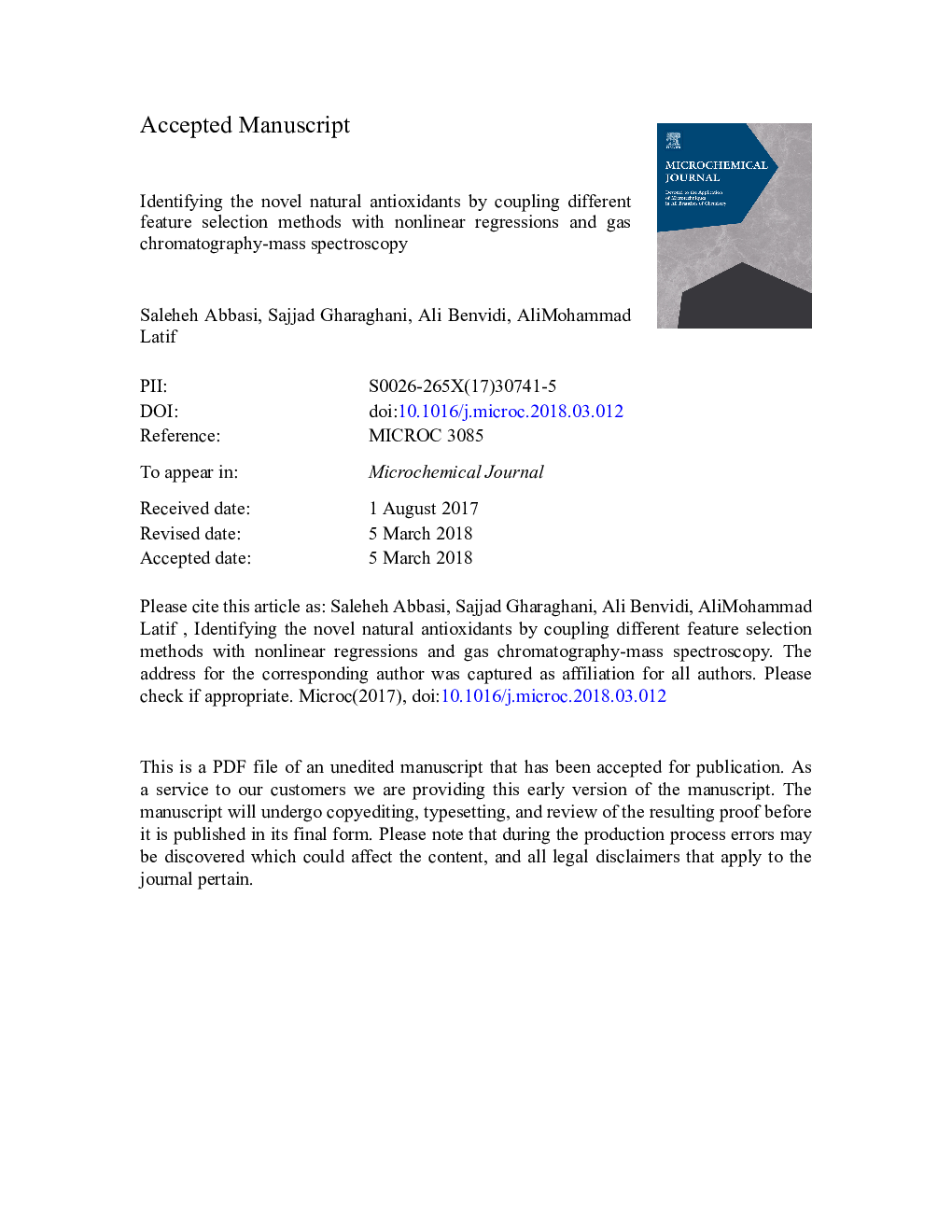| کد مقاله | کد نشریه | سال انتشار | مقاله انگلیسی | نسخه تمام متن |
|---|---|---|---|---|
| 7640888 | 1494855 | 2018 | 38 صفحه PDF | دانلود رایگان |
عنوان انگلیسی مقاله ISI
Identifying the novel natural antioxidants by coupling different feature selection methods with nonlinear regressions and gas chromatography-mass spectroscopy
ترجمه فارسی عنوان
شناسایی آنتی اکسیدان های طبیعی رمان با ترکیب روش های مختلف انتخاب ویژگی با رگرسیون های غیر خطی و طیف سنجی جرم کروماتوگرافی گاز
دانلود مقاله + سفارش ترجمه
دانلود مقاله ISI انگلیسی
رایگان برای ایرانیان
کلمات کلیدی
موضوعات مرتبط
مهندسی و علوم پایه
شیمی
شیمی آنالیزی یا شیمی تجزیه
چکیده انگلیسی
There are numerous reactive compounds such as free radicals which the body is less capable of fighting off these unwanted dangerous molecules. These conditions, known as oxidative stress, reflect an imbalance between free radical generation and the ability of the body to neutralize these reactive intermediates by antioxidants. Some spices show antioxidant activities that provide an added source of antioxidants for the body to fight against free radicals. Without the necessary intake of these plants, free radicals can lead to various types of diseases. However, the contribution of each chemical composition in the antioxidant activity is unclear. To produce effective food supplements as well as pharmaceutical formulations from these herbs, the responsible components for the antioxidant activity should be identified. Nowadays, the integration of chemoinformatics methods with chromatographic techniques allows us to identify and predict the antioxidant activity of medicinal plants. This study presents a new drug discovery strategy for the quantitative chemical component-antioxidant activity relationship (QCAR) model. This strategy includes multi-objective feature selection (FS) algorithms based on artificial neural network (ANN) to identify novel antioxidants. This screening strategy leads to discovery of the new synergistic effects of non-phenolic compounds (i.e. γ-terpinene, p-cymene and caryophyllene). In order to examine the performance of the designed model, the volatile components of hydrodistilled essential oil of Mentha samples were analyzed using gas chromatography-mass spectrometry and their antioxidant activities were measured by a 1,1-diphenyl-2-picrylhydrazyl radical (DPPH) scavenging test. Also, antioxidant activities of Mentha samples were predicted using QCAR model. The values predicted from the computational approaches have a reasonable agreement with the actual values obtained from DPPH assay. Finally, the designed method proves to be effective procedures for both predicting the antioxidant activity of the essential oil samples and finding the most important antioxidant compounds.
ناشر
Database: Elsevier - ScienceDirect (ساینس دایرکت)
Journal: Microchemical Journal - Volume 139, June 2018, Pages 372-379
Journal: Microchemical Journal - Volume 139, June 2018, Pages 372-379
نویسندگان
Saleheh Abbasi, Sajjad Gharaghani, Ali Benvidi, AliMohammad Latif,
